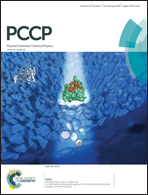Atomistic insights into the nanohelix of hydrogenated graphene: formation, characterization and application
Abstract
Hydrogenated graphene has been emerging as the cynosure of the subject for numerous studies due to its conductivity, ferromagnetism, and potential for energy storage as well as drug delivery. However, how to find a decent way to overcome the graphene bending barrier and modify graphene from planar structures to 3D structures remains to be further explored. By virtue of molecular mechanics/dynamics simulations, here we present the formation of a carbon nanohelix from a pristine graphene nanoribbon by doping it with hydrogen atoms in a specific pattern. Meanwhile, we quantitatively investigate the effect of the interatomic potential on the process of helical structure formation, thermal stability and mechanical properties of the carbon nanohelix as well as its potential application in molecule packing. The carbon nanohelix portrays an intriguing zigzag strain–stress curve and amazing extensibility under tension as well as relatively limited deformability under compression, which represents its unique signature of mechanical properties to differentiate the carbon nanohelix from the behavior of the carbon nanotube and graphene. These findings lend compelling credence to envision that the carbon nanohelix opens up a viable avenue for nanofabrication and is perceived as a novel nanomaterial for a variety of applications such as electronics, sensors, energy storage, drug delivery and nanocomposites.


 Please wait while we load your content...
Please wait while we load your content...